Saturday, January 08, 2005
Billon antoninianus, Valerian II, Rome, Göbl Vj.248(3)
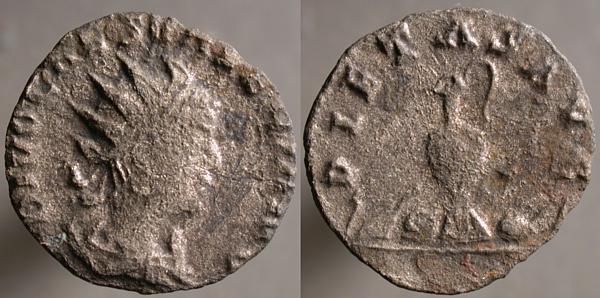
DIVO CAES VALERIANO, Radiate draped bust right | PIETAS AVGG, Sacrificial implements. (Göbl geräte 1.)
An oddity: a mule that mismatches a posthumous obverse of Valerian II with an obverse used on coins issued during his lifetime.
Friday, January 07, 2005
Æ27, Smyrna in Ionia, Gallienus, SNG Copenhagen 1410 var
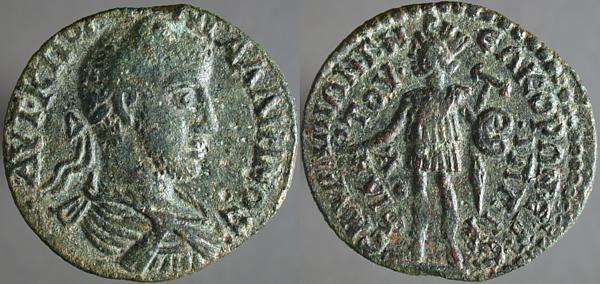
ΑVΤ Κ Π ΛΙΚ ΓΑΛΛΙΗΝΟC, Laureate draped cuirassed bust right | CΜΥΡΝΑΙΟΝ Γ Ν_ΕΟΚΟΡΟΝ[..] ΠΙ[...] ΦΙΛ[..] ΤΟΥ, The amazon Smyrna, turreted and cuirassed, standing facing, head left, holding bipennis (double-bitted battle-axe) and pelta (shield) right.
I find it a bit curious that Gallienus is portrayed most commonly on Imperial coins with just a head. Drapery and cuirass are by now means rare, but less frequently seen than not seen.
On the provincial coins though, a cuirass, with or without drapery, is nearly always worn. The emperor's preference, or that of the residents?
Update: After obtaining another coin of this city and magistrates, I believe a more accurate reading of the legends is AVT K Π ΛIK_[IN] ΓAΛΛIHNOC / CMYPNAIΩN Γ N_EΩKOPΩN[..] IΠ[ΠIKOV] ΦIΛH_TOV
Thursday, January 06, 2005
Silvered Æ antoninianus, Gallienus, Rome, Göbl 493f
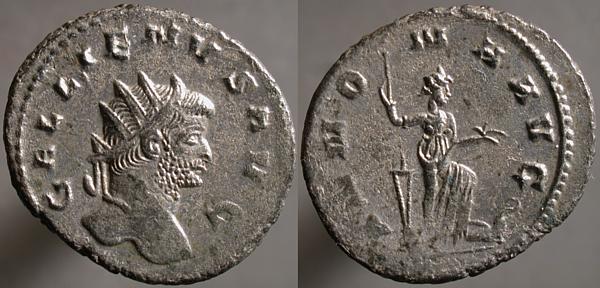
GALLIENVS AVG, Radiate head right | ANNONA AVG, Annona standing facing on prow right, head right, holding oar left and ears of grain right.
Back in February I posted this related coin, an example of 493q¹ with a reverse that is not as Göbl described but which does match the plate.
Today's coin does have the expected reverse, with Annona standing on the prow (of a grain ship), rather than on a modius (a quarter-bushel basket used to carry grain.)
Wednesday, January 05, 2005
AR antoninianus, Caracalla, Rome, RIC 311
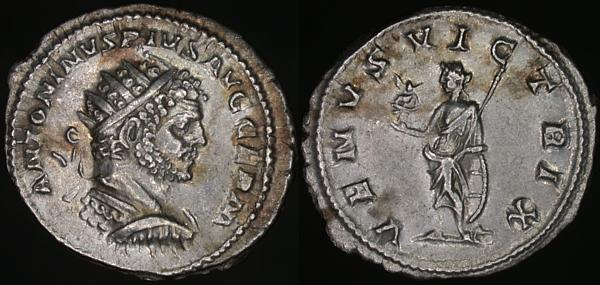
ANTONINVS PIVS AVG GERM, Radiate cuirassed bust right, seen from slightly behind | VENVS VICTRIX, Venus standing facing, head left, holding Victory left and scepter right, shield resting on helmet on the ground right.
Marcus Aurelius Antoninus was the elder son of Septimius Severus, and brother (and assassin) of Geta. The nickname Caracalla refers to a type of German cloak that he favored.
Much of his reign was spent leading the army, but he did take time to conduct a massacre at Alexandria in 216.
He was assassinated by his Praetorian guards in 217 and succeeded by their leader, Macrinus.
The antoninianus was introduced in the time of Caracalla, a coin about 50% heavier than the denarius, believed to have been tariffed at two denarii.
Tuesday, January 04, 2005
Æ21, Heliopolis in Coele-Syria, Gallienus, Lindgren I, 2173
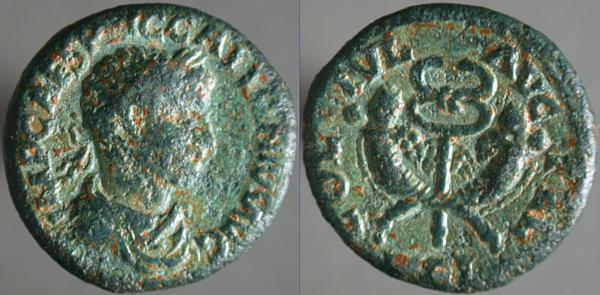
IMP CAES P LIC GALLIENVS AVG, Laureate draped bust right | COL IVL AVG FEL HEL, Winged cauduceus behind two crossed cornucopias.
A rather archaic design, coins with similar reverses had been minted at least as far back as the Julio-Claudian emperors, over two centuries before.
Monday, January 03, 2005
Silvered Æ antoninianus, Gallienus, Rome, Göbl 518tvar
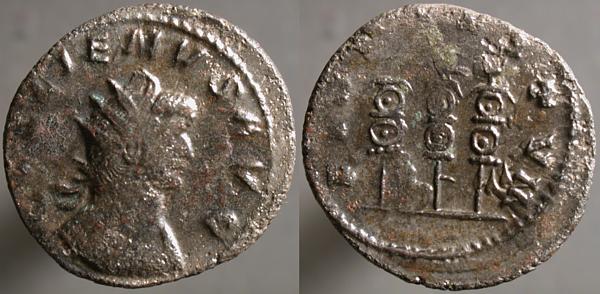
GALLIENVS AVG, Radiate cuirassed bust right | FID MILITVM, Three standards.
I find this one very interesting. It's a bit different than what's recorded. Robert Göbl lists a type (518) which uses this three-standard design, but the legend FIDEI PRAET. He lists a type (526) with this FID MILITVM legend, but the design is Fides between two standards. Both of those coins are listed as part of a series that honors Gallienus's Decennalia, the tenth anniversary of his becoming emperor, so they would have been made at about the same time, and it's not unreasonable to think that an engraver who'd produced dies for both of them made an error and muddled them a bit. Nothing that I know about quality control at the Roman mint in the middle of the 3rd Century says that such a die would have been discarded, so thousands of coins struck from that die should have been produced, but this seems to be the only one that anyone's noticed.
Sunday, January 02, 2005
Æ tetradrachm, Alexandria, Valerian, Emmett 3705(4)

Α Κ Π ΛΙ ΟVΑΛΕΡΙΑΝΟC ΕVΕVC, Laureate cuirassed bust right | L_Δ, Eagle standing left, head right, wreath in beak. Regnal year across fields.
Eagles are a common theme on Alexandrian coins, back to the Ptolemaic dynasty, and they suited the Romans well. I particularly like the details on Valerian's cuirass here.

